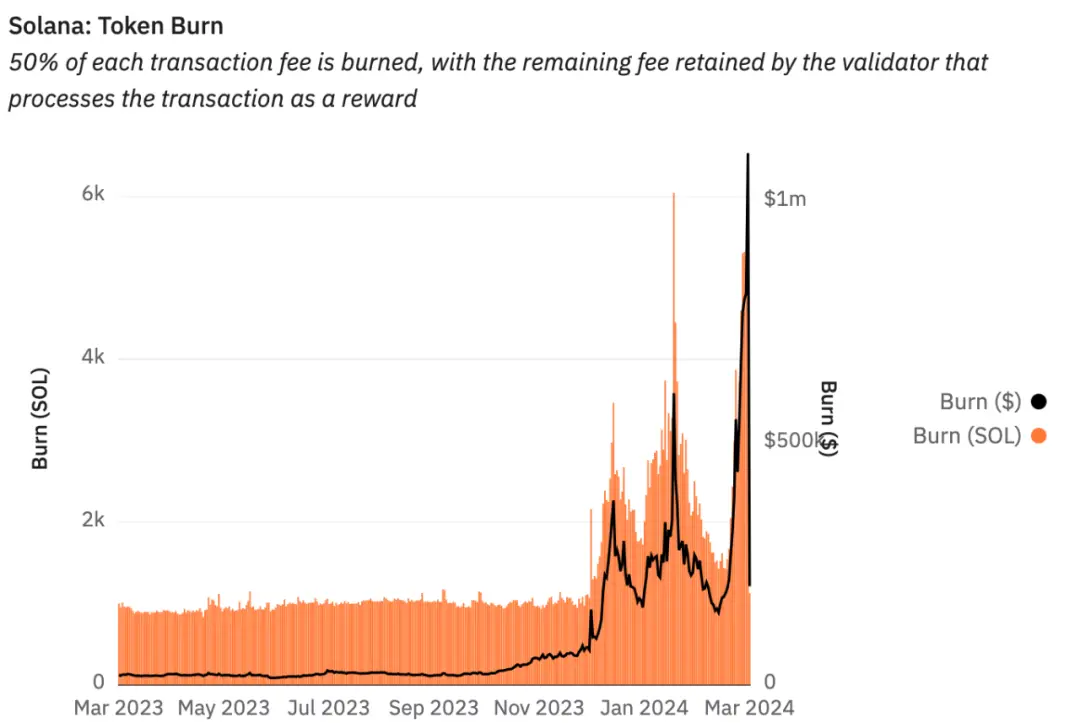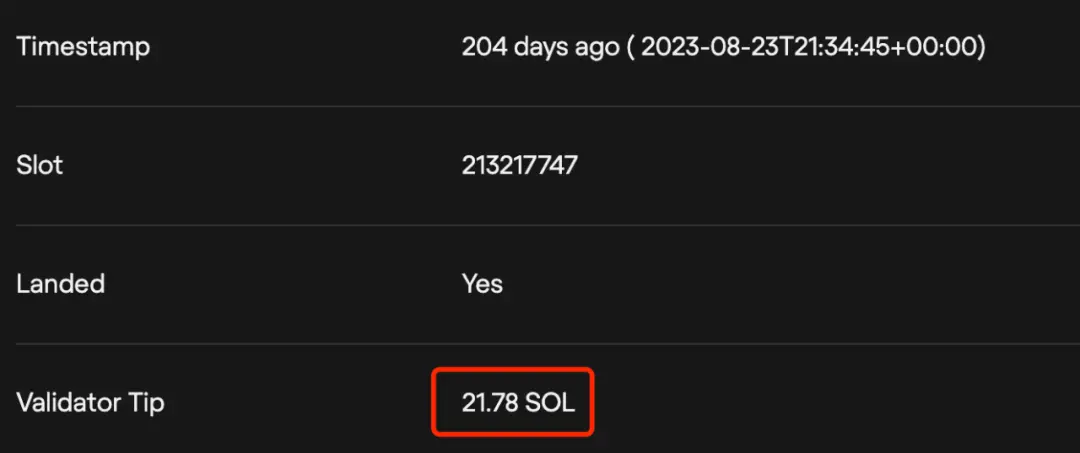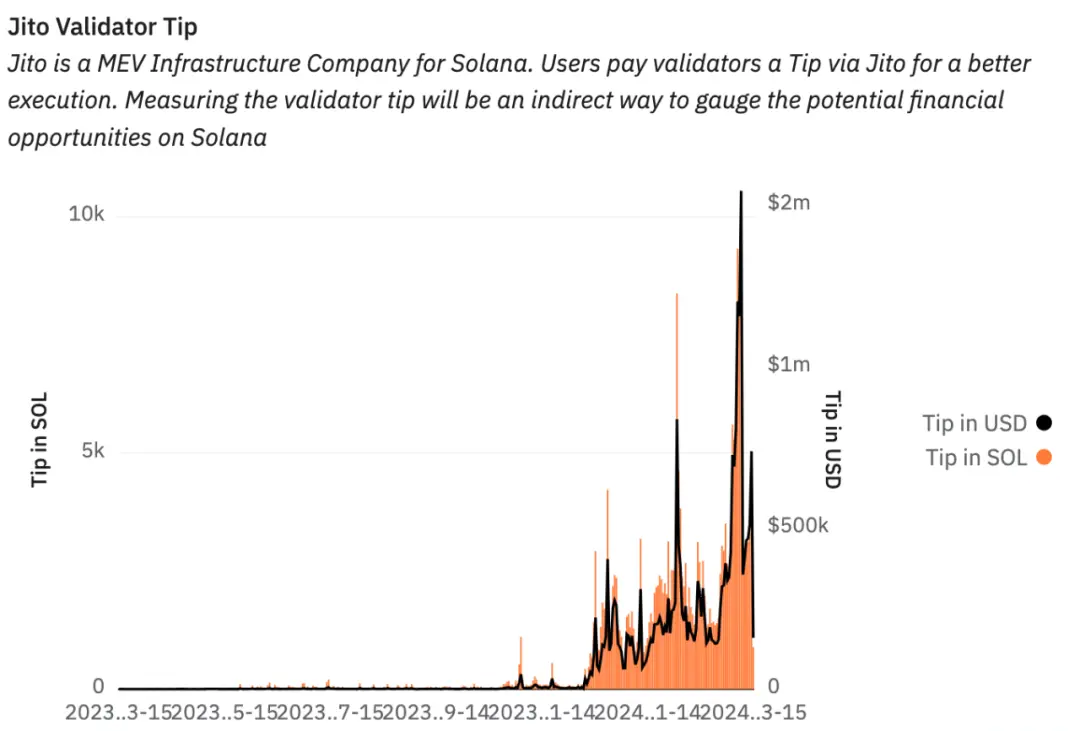Crazy BOME craze, interpreting the MEV problem behind Solana Meme craze
Meme tokens in the Solana ecosystem have been the focus of the market recently. BONK, Dogewifhat or some deliberately misspelled celebrity meme tokens have become the targets of crazy pursuit by crypto users. Dogewifhat is even listed on Robinhood Crypto and Binance, with a market value of over US$3 billion. On March 15, the BOME token launched by crypto artist Darkfarms increased more than 47 times in 24 hours, with trading volume exceeding US$300 million.
The problem that comes with the meme craze is that when users purchase meme tokens on the decentralized platform of the Solana chain, they are frequently subjected to sandwich attacks, resulting in high prices for meme tokens and losses. . This type of bot is a MEV attack. What is MEV? What impact does it have on the blockchain ecosystem? How does Solana handle issues caused by MEV? Today Beosin will analyze it one by one for everyone.
MEV and trading opportunities
The full name of MEV is Maximal Extractable Value, which means the maximum extractable value. Initially, MEV refers to Miner Extractable Value, that is, in the Bitcoin network, miners can obtain profits beyond the block and network fees by reordering transactions in the block. However, MEV actually has nothing to do with the type of different blockchain networks. In fact, similar situations exist in all public chain networks, so MEV is expanded from the category of miner extractable value (Miner Extractable Value) to the maximum extractable value (Maximal Extractable Value).
MEV is similar to a fee that is charged to ordinary users by participants who maintain the blockchain network. This may seem like a burden, but in fact MEV promotes the development of the blockchain network and the stability of the ecological economy. plays an important role.
Since miners/validators can reorder transactions in a block, MEV is often used in the following strategies:
1. Atomic arbitrage
Arbitrageurs will Take advantage of the opportunity of MEV to discover price differences on the same trading pair in different liquidity pools on the blockchain. They will do whatever they can to get transactions packaged in the same block to make a profit. Through this arbitrage behavior, the prices of assets in different liquidity pools can be effectively balanced to ensure market stability and equilibrium. The behavior of arbitrageurs is based on keen insight and quick response to market opportunities. They obtain profits by taking advantage of the price difference between trading pairs, thereby promoting the efficient operation of the market
2. Liquidation
When conducting on-chain lending business, in order to avoid adverse consequences, lending protocols usually allow third-party liquidators to participate in the liquidation of collateral to ensure the stable operation of the protocol. For example, MakerDAO allows users to borrow and lend using assets such as ETH, with liquidation bots handling potential profit opportunities. This liquidation method is designed to maintain the smooth operation of the agreement while protecting the interests of both borrowers and lenders.
3. Sandwich attack
Use AMM’s price calculation mechanism to make profits by buying in advance of ordinary users in a block and then selling in advance, thus completing the victim’s transaction first. Purchase transaction.
There are other profitable activities such as IDO, INO preemptive purchase of tokens, minting NFT, etc., and MEV can also be used to make profits.
SolanaMEV
Solana is similar to public chains such as ETH and uses PoS to ensure security. Due to the extremely high requirements for Solana's node operation, ordinary users cannot run Solana's verification nodes. Most of Solana's validation nodes are located in data centers that handle massive amounts of data. Validation nodes hosted in data centers can take advantage of network advantages and parallel design to process more transactions and obtain more block rewards.
50% of all transaction fees collected by validators need to be destroyed. The purpose of this is to incentivize validators to process as many transactions as possible within the allotted period.

Solana’s on-chain handling fee destruction hits a new high in recent years: https://dune.com/21co/solana-key-metrics
at On Solana, a block is produced approximately every 400 ms. Previously, due to Solana’s first-come-first-out transaction processing mechanism, taking advantage of MEV had to compete for low latency rather than high fees. Being able to read the block state first means being able to execute profitable transactions with a higher probability.
Previously, to utilize MEV on Solana, you needed to run a node to read the latest network status and be a high-stake validator. This solution is demanding and costly.
Solana front-running strategy
1. Spam transactions
Previously, due to Solana’s first-in-first-out transaction processing mechanism, spamming spam transactions has always been the most common way to front-run. This method does not work on Solana. Many people have used this method to make profits on Friend.tech of the Base chain. However, this method requires the verifier to process a large number of failed transactions. In severe cases, it may overload the verifier's processing capacity, lead to inconsistent consensus, and finally force the network to interrupt.
2. Priority gas fees
Priority gas fees are part of a new upgrade to Solana designed to address and reduce transaction spam by creating new incentives for transaction priority. The priority gas fee determines priority inclusion in the block (a more costly method) based on the gas level, thereby helping to reduce spam transactions.
The introduction of this mechanism will increase the cost of generating spam transactions. However, the priority gas fee needs to always be high enough to ensure that spamming senders are incurring substantial costs in real terms.
Additionally, the introduction of priority gas fees enables users to express their desire for priority confirmation of transactions in a fair and competitive manner. Solana's mechanism is actually similar to Ethereum. We can see Solana's gas war:

It consumes 21.78 SOL to confirm the transaction: https: //explorer.jito.wtf/bundle/a6fb6ad4f7f4ad1f797c2115f688e6bc178f2609a1a420769af97a17b6dbde4c
3.Jito-Solana
Jito-Solana is like Solana’s Flashbot, by introducing mempool and block Space auction mechanism, users submit the transaction packages they want to be included in the block and the client bidding for these packages to the validator running Jito-Solana. The highest bidder wins and their bundle is committed on-chain, creating an additional revenue stream for validators and their stakeholders. The tip (Tip) paid is 100% paid to the verifier and its stakers:

https://dune.com/21co/solana-key- metrics
Currently, Jito-Solana client accounts for 66% of the verification node client market share, becoming Solana’s mainstream verification client. Validator MEV rewards and the number of validators adopting the Jito client (currently 814) indicate that more and more Solana participants are considering or are already practicing how to use MEV to capture/distribute profits on Solana.
In this Solana meme craze, sandwich attacks launched through Jito have made ordinary users miserable. Not long ago Jito announced that it would temporarily shut down its mempool to reduce sandwich attacks:

##https://twitter.com/jito_labs/status/1766228889888514501
How to treat MEV correctly? MEV is not something that can really be eliminated. The focus of MEV research should be on how to use MEV to benefit ordinary users and applications in the ecosystem: For example, Jito guides Solana validators to choose their clients through MEV, increasing the diversity of Solana clients. Of course, currently due to its network effect , which has led to certain centralization issues; using MEV to save the assets of users and protocols; using MEV to redistribute the benefits generated by the network, these are all aspects of MEV that are beneficial to the entire blockchain network ecology.The above is the detailed content of Crazy BOME craze, interpreting the MEV problem behind Solana Meme craze. For more information, please follow other related articles on the PHP Chinese website!

Hot AI Tools

Undresser.AI Undress
AI-powered app for creating realistic nude photos

AI Clothes Remover
Online AI tool for removing clothes from photos.

Undress AI Tool
Undress images for free

Clothoff.io
AI clothes remover

Video Face Swap
Swap faces in any video effortlessly with our completely free AI face swap tool!

Hot Article

Hot Tools

Notepad++7.3.1
Easy-to-use and free code editor

SublimeText3 Chinese version
Chinese version, very easy to use

Zend Studio 13.0.1
Powerful PHP integrated development environment

Dreamweaver CS6
Visual web development tools

SublimeText3 Mac version
God-level code editing software (SublimeText3)

Hot Topics
 1389
1389
 52
52
 Despite the speed of market rewards, every coin will eventually encounter pressure and cannot be ignored.
Apr 21, 2025 pm 01:18 PM
Despite the speed of market rewards, every coin will eventually encounter pressure and cannot be ignored.
Apr 21, 2025 pm 01:18 PM
The crypto market is changing with opportunities and risks coexisting, and every cryptocurrency is facing tremendous pressure. This article will analyze the current situation of three cryptocurrencies: Sui, Ethereum and BlockDag, and explore the reasons and future trends behind their price fluctuations. Sui: Price is under pressure, and the future trend is unknown. Sui's price trend shows a classic head and shoulder reversal pattern. The current price hovers around US$2.22, down 8.73% from the neckline of US$2.52. In the past 24 hours, nearly US$1.92 million long positions have been closed, and shorts have dominated. Although the MACD indicator bent slightly upward, the volume was insufficient, with support at $2.16 and $1.42 respectively. Unless the bulls break through the $2.52 resistance level, S
 Rexas Finance (RXS) can surpass Solana (Sol), Cardano (ADA), XRP and Dogecoin (Doge) in 2025
Apr 21, 2025 pm 02:30 PM
Rexas Finance (RXS) can surpass Solana (Sol), Cardano (ADA), XRP and Dogecoin (Doge) in 2025
Apr 21, 2025 pm 02:30 PM
In the volatile cryptocurrency market, investors are looking for alternatives that go beyond popular currencies. Although well-known cryptocurrencies such as Solana (SOL), Cardano (ADA), XRP and Dogecoin (DOGE) also face challenges such as market sentiment, regulatory uncertainty and scalability. However, a new emerging project, RexasFinance (RXS), is emerging. It does not rely on celebrity effects or hype, but focuses on combining real-world assets (RWA) with blockchain technology to provide investors with an innovative way to invest. This strategy makes it hoped to be one of the most successful projects of 2025. RexasFi
 Asset Manager Canary Capital is seeking SEC approval to launch SUI Exchange Trade's fund with points
Apr 21, 2025 pm 02:36 PM
Asset Manager Canary Capital is seeking SEC approval to launch SUI Exchange Trade's fund with points
Apr 21, 2025 pm 02:36 PM
Share this article! CanaryCapital Asset Management plans to launch its first spot cryptocurrency exchange-traded fund (ETF) that tracks the price of SUI (Sui). The company has filed an application with the U.S. Securities and Exchange Commission (SEC) seeking approval to issue its SUIETF. This will be the first ETF to track the performance of a well-known Layer-1 network. The ETF plans to leverage some of its positions through trusted staking providers. “The issuer may utilize or motivate all or part of the SUI of the Trust Fund to participate in Staking through one or more trusted Staking providers. Considering any of the Trusts’ possible participation in any
 How to choose a virtual currency exchange app? 2025 Crypto Circle App Exchange Authoritative Ranking
Apr 21, 2025 pm 12:33 PM
How to choose a virtual currency exchange app? 2025 Crypto Circle App Exchange Authoritative Ranking
Apr 21, 2025 pm 12:33 PM
Against the backdrop of the rapid development of today's digital currency market, choosing a reliable exchange app has become the top priority of every investor. The authoritative rankings of the 2025 CNY App Exchange provide you with a detailed guide to help you find the platform that suits you the most among the many options. We will evaluate from multiple dimensions such as security, user experience, handling fees, and transaction volume to ensure that you can find a safe, convenient and efficient trading platform. Next, let’s take a look at what are the top three exchange apps.
 Binance Binance Exchange official app v2.98.6 latest version download (with registration tutorial)
Apr 21, 2025 pm 12:45 PM
Binance Binance Exchange official app v2.98.6 latest version download (with registration tutorial)
Apr 21, 2025 pm 12:45 PM
As the world's leading cryptocurrency trading platform, Binance Binance Exchange has powerful features and excellent user experience. The latest version of v2.98.6 brings more functional optimization and security improvements, ensuring that you are smoother and safer during the transaction process. This article will introduce in detail how to download and install the official app v2.98.6 of Binance Exchange, and comes with a registration tutorial to help you get started quickly.
 Bitcoin (BTC) Price Forecast: Can cryptocurrencies become a safe haven as the U.S. stock market plummets?
Apr 21, 2025 pm 01:00 PM
Bitcoin (BTC) Price Forecast: Can cryptocurrencies become a safe haven as the U.S. stock market plummets?
Apr 21, 2025 pm 01:00 PM
Since April 2, the "Liberation Day", the U.S. stock market has experienced unprecedented drastic fluctuations. The US's aggressive trade policy caught Wall Street off guard, triggering panic selling and violent shocks last week. The Dow Jones Index plummeted 4,000 points in just 48 hours, setting an unprecedented record of falling more than 1,500 points on two consecutive days in history. Meanwhile, the S&P 500 fell 10.5%, and its market value evaporated by nearly $5 trillion. False information and speculative market false information plays an important role in recent market fluctuations. For example, a Twitter account with about 1,000 followers claimed that the United States would suspend tariffs for 90 days, and was then forwarded by another account with about 800,000 followers, "Walter Bloomberg." This incident caused severe market fluctuations and stock prices soared.
 Unlock Binance KERNEL airdrop, new gameplay for BNB holding positions
Apr 21, 2025 pm 01:06 PM
Unlock Binance KERNEL airdrop, new gameplay for BNB holding positions
Apr 21, 2025 pm 01:06 PM
In the tide of cryptocurrencies, new opportunities and projects continue to emerge. Recently, the KernelDAO (KERNEL) project launched by Binance has attracted much attention, bringing new gameplay and benefits to BNB holders.
 Understand one article: Binance KERNEL Airdrop Process
Apr 21, 2025 pm 01:09 PM
Understand one article: Binance KERNEL Airdrop Process
Apr 21, 2025 pm 01:09 PM
In the world of cryptocurrencies, new opportunities always emerge. Recently, the KernelDAO (KERNEL) Megadrop project launched by Binance has attracted widespread attention. This project not only brings new investment options to investors, but also provides unique benefits to BNB holders. So, what exactly is KernelDAO? How will this airdrop be carried out? Let us understand it in one article.



